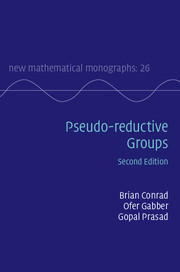Book contents
- Frontmatter
- Dedication
- Contents
- Preface to the second edition
- Introduction
- Terminology, conventions, and notation
- PART I Constructions, examples, and structure theory
- 1 Overview of pseudo-reductivity
- 2 Root groups and root systems
- 3 Basic structure theory
- PART II Standard presentations and their applications
- PART III General classification and applications
- PART IV Appendices
- References
- Index
2 - Root groups and root systems
from PART I - Constructions, examples, and structure theory
Published online by Cambridge University Press: 05 June 2015
- Frontmatter
- Dedication
- Contents
- Preface to the second edition
- Introduction
- Terminology, conventions, and notation
- PART I Constructions, examples, and structure theory
- 1 Overview of pseudo-reductivity
- 2 Root groups and root systems
- 3 Basic structure theory
- PART II Standard presentations and their applications
- PART III General classification and applications
- PART IV Appendices
- References
- Index
Summary
The category of pseudo-reductive groups over a field k has weak stability properties under basic operations on group schemes, such as extension of the base field and passage to quotients (even by finite central multiplicative or smooth normal closed subgroups). Fortunately, pseudo-reductive groups do satisfy many properties generalizing those of connected reductive groups, and this chapter establishes such properties for convenient use later on.
Following Tits, we use an interesting construction of unipotent groups to construct a theory of root systems and root groups for pseudo-reductive groups over any separably closed field, or more generally for pseudo-split pseudo-reductive groups, i.e., the ones which contain a split maximal torus (over an arbitrary ground field). Tits developed a version of this theory without requiring a split maximal torus, but it will suffice for our needs in the main body of this book to have this theory for pseudo-split groups. In Appendix C we give a detailed exposition of k-root systems, relative Weyl groups, and k-root groups, as well as construct a Tits system in G(k) for any smooth connected affine group G over any field k; see C.2.13 to C.2.34.
In contrast with the connected reductive case, root groups in pseudo-split pseudo-reductive groups over a field k may have dimension larger than 1, though they turn out to always be vector groups over k (i.e., k-isomorphic to a power of Ga). Our structure theorem for pseudo-reductive groups explains a posteriori why root groups can have large dimension: they turn out to naturally be Weil restrictions of 1-dimensional vector groups over a finite extension of k if char(k) ≠ 2, and we prove a related result when char(k) = 2.
Limits associated to 1-parameter subgroups
The construction of root groups rests on a generalization to pseudo-reductive groups of the theory of parabolic subgroups and their unipotent radicals in connected reductive groups.
- Type
- Chapter
- Information
- Pseudo-reductive Groups , pp. 44 - 91Publisher: Cambridge University PressPrint publication year: 2015



